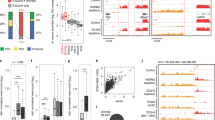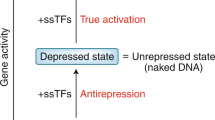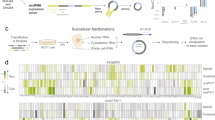Abstract
Alternative promoters within the same gene are a general phenomenon in gene expression1,2. Mechanisms of their selective regulation vary from one gene to another and are still poorly understood. Here we show that in quiescent cells the mechanism of transcriptional repression of the major promoter of the gene encoding dihydrofolate reductase depends on a non-coding transcript initiated from the upstream minor promoter and involves both the direct interaction of the RNA and promoter-specific interference. The specificity and efficiency of repression is ensured by the formation of a stable complex between non-coding RNA and the major promoter, direct interaction of the non-coding RNA with the general transcription factor IIB and dissociation of the preinitiation complex from the major promoter. By using in vivo and in vitro assays such as inducible and reconstituted transcription, RNA bandshifts, RNA interference, chromatin immunoprecipitation and RNA immunoprecipitation, we show that the regulatory transcript produced from the minor promoter has a critical function in an epigenetic mechanism of promoter-specific transcriptional repression.
This is a preview of subscription content, access via your institution
Access options
Subscribe to this journal
Receive 51 print issues and online access
$199.00 per year
only $3.90 per issue
Buy this article
- Purchase on Springer Link
- Instant access to full article PDF
Prices may be subject to local taxes which are calculated during checkout




Similar content being viewed by others
References
Ayoubi, T. A. & Van De Ven, W. J. Regulation of gene expression by alternative promoters. FASEB J. 10, 453–460 (1996)
Martens, J. A., Laprade, L. & Winston, F. Intergenic transcription is required to repress the Saccharomyces cerevisiae SER3 gene. Nature 429, 571–574 (2004)
Masters, J. N. & Attardi, G. Discrete human dihydrofolate reductase gene transcripts present in polysomal RNA map with their 5′ ends several hundred nucleotides upstream of the main mRNA start site. Mol. Cell. Biol. 5, 493–500 (1985)
Blume, S. W., Meng, Z., Shrestha, K., Snyder, R. C. & Emanuel, P. D. The 5′-untranslated RNA of the human dhfr minor transcript alters transcription pre-initiation complex assembly at the major (core) promoter. J. Cell. Biochem. 88, 165–180 (2003)
Hendrickson, S. L., Wu, J. S. & Johnson, L. F. Cell cycle regulation of dihydrofolate reductase mRNA metabolism in mouse fibroblasts. Proc. Natl Acad. Sci. USA 77, 5140–5144 (1980)
Akoulitchev, S., Makela, T. P., Weinberg, R. A. & Reinberg, D. Requirement for TFIIH kinase activity in transcription by RNA polymerase II. Nature 377, 557–560 (1995)
Orphanides, G., Lagrange, T. & Reinberg, D. The general transcription factors of RNA polymerase II. Genes Dev. 10, 2657–2683 (1996)
Kim, J. L., Nikolov, D. B. & Burley, S. K. Co-crystal structure of TBP recognizing the minor groove of a TATA element. Nature 365, 520–527 (1993)
Nikolov, D. B. et al. Crystal structure of a TFIIB-TBP-TATA-element ternary complex. Nature 377, 119–128 (1995)
Lagrange, T. et al. High-resolution mapping of nucleoprotein complexes by site-specific protein-DNA photocrosslinking: organization of the human TBP-TFIIA-TFIIB-DNA quaternary complex. Proc. Natl Acad. Sci. USA 93, 10620–10625 (1996)
Gilbert, C., Kristjuhan, A., Winkler, G. S. & Svejstrup, J. Q. Elongator interactions with nascent mRNA revealed by RNA immunoprecipitation. Mol. Cell 14, 457–464 (2004)
Kazmi, M. A., Dubin, R. A., Oddoux, C. & Ostrer, H. High-level inducible expression of visual pigments in transfected cells. Biotechniques 21, 304–311 (1996)
Xu, Z. L., Mizuguchi, H., Mayumi, T. & Hayakawa, T. Regulated gene expression from adenovirus vectors: a systematic comparison of various inducible systems. Gene 309, 145–151 (2003)
Morgan, A. R. & Wells, R. D. Specificity of the three-stranded complex formation between double-stranded DNA and single-stranded RNA containing repeating nucleotide sequences. J. Mol. Biol. 37, 63–80 (1968)
Letai, A. G., Palladino, M. A., Fromm, E., Rizzo, V. & Fresco, J. R. Specificity in formation of triple-stranded nucleic acid helical complexes: studies with agarose-linked polyribonucleotide affinity columns. Biochemistry 27, 9108–9112 (1988)
Marck, C. & Thiele, D. Poly(dG).poly(dC) at neutral and alkaline pH: the formation of triple stranded poly(dG).poly(dG).poly(dC). Nucleic Acids Res. 5, 1017–1028 (1978)
Carbone, G. M., McGuffie, E. M., Collier, A. & Catapano, C. V. Selective inhibition of transcription of the Ets2 gene in prostate cancer cells by a triplex-forming oligonucleotide. Nucleic Acids Res. 31, 833–843 (2003)
Gee, J. E., Blume, S., Snyder, R. C., Ray, R. & Miller, D. M. Triplex formation prevents Sp1 binding to the dihydrofolate reductase promoter. J. Biol. Chem. 267, 11163–11167 (1992)
Roberts, S. G. & Green, M. R. Activator-induced conformational change in general transcription factor TFIIB. Nature 371, 717–720 (1994)
Janowski, B. A. et al. Involvement of AGO1 and AGO2 in mammalian transcriptional silencing. Nat. Struct. Mol. Biol. 13, 787–791 (2006)
Kim, D. H., Villeneuve, L. M., Morris, K. V. & Rossi, J. J. Argonaute-1 directs siRNA-mediated transcriptional gene silencing in human cells. Nat. Struct. Mol. Biol. 13, 793–797 (2006)
Acknowledgements
We thank members of the laboratory for advice and support, N. Rust for providing support in flow cytometry analysis, S. Roberts and T. Oelgeschlaeger for suggestions, and J. Svejstrup for advice on the RNA immunoprecipitation procedure. This work was supported by grants from the Wellcome Trust and Medical Research Council. I.M. was supported by EMBO long-term fellowship.
Author information
Authors and Affiliations
Corresponding author
Ethics declarations
Competing interests
Reprints and permissions information is available at www.nature.com/reprints. The authors declare no competing financial interests.
Supplementary information
Supplementary Methods
This file contains Supplementary Methods and additional references (PDF 69 kb)
Rights and permissions
About this article
Cite this article
Martianov, I., Ramadass, A., Serra Barros, A. et al. Repression of the human dihydrofolate reductase gene by a non-coding interfering transcript. Nature 445, 666–670 (2007). https://doi.org/10.1038/nature05519
Received:
Accepted:
Published:
Issue Date:
DOI: https://doi.org/10.1038/nature05519
This article is cited by
-
Epigenetic modifications in the development of bronchopulmonary dysplasia: a review
Pediatric Research (2024)
-
Chromatin balances cell redox and energy homeostasis
Epigenetics & Chromatin (2023)
-
Functional Mutations in the microRNA-155 Promoter Modulate its Transcription Efficiency and Expression
Molecular Biotechnology (2023)
-
Long Non-coding RNA Involved in the Pathophysiology of Atrial Fibrillation
Cardiovascular Drugs and Therapy (2023)
-
Non-Coding RNA-Mediated Gene Regulation in Cardiovascular Disorders: Current Insights and Future Directions
Journal of Cardiovascular Translational Research (2023)
Comments
By submitting a comment you agree to abide by our Terms and Community Guidelines. If you find something abusive or that does not comply with our terms or guidelines please flag it as inappropriate.



